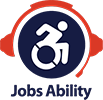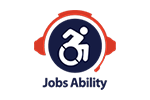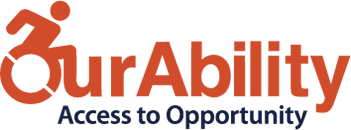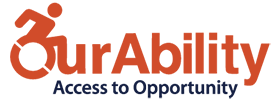
Real-Life Experience a Big Differentiator for Our Ability and Its Job Portal
July 5, 2023
Jobs Ability June 2023 Statistics
July 17, 2023Robinson: Emerging Technology a Game Changer in Disability Employment Space

By Dave Allen
When John Robinson founded Our Ability in 2011, he envisioned the company as a mentoring network for people with disabilities. Using the HuffPost as a roadmap, Our Ability would produce and share video stories about individuals with disabilities, creating a network of videos to inspire and empower the disabled to be more successful in life. But as Robinson traveled around the country speaking to various corporations, he discovered that many of the individuals with disabilities he met shared one particular frustration—they all had a hard time finding a job. Robinson, in fact, applied for hundreds of jobs before he landed his first full-time position.
“That’s when I realized there was an opportunity here to create something that could help the next generation in a way where I didn’t have that help,” Robinson says. “The video stories were great, but that’s not ultimately what people wanted. The younger people who were watching the stories would email us and say, ‘Hey, this is great, can we send you our resume?’ And the companies we spoke to wanted to know if they could post jobs on our website. Very quickly, the site became transactional in that the people wanted to upload their resumes and companies wanted to post jobs.”
So, Our Ability pivoted as a company, creating a job board for people with disabilities and dedicating itself to helping match these individuals with jobs. The unemployment rate for people with disabilities in May 2023 was 8.3 percent in individuals ages 16 to 64, according to the U.S Department of Labor. That’s down nearly half from 15 percent in 2011.
Emerging technologies, such as generative AI, or artificial intelligence, are a big reason behind the decrease in the unemployment rate for people with disabilities. They’re making it much easier for individuals with disabilities to not only connect with employers, but also find job opportunities that match their lifetime goals. In the following Q&A, Robinson talks about the growth of Our Ability’s job placement platform, Jobs Ability, and the role emerging technology will have in placing people with disabilities in the future.
Q: What were some of the biggest challenges you faced in terms of finding a job after graduating from college?
A: The greatest challenge was getting someone to believe I could do the work, to understand that I actually had the skills to do that job. I remember having two major interviews—one with a major TV network in New York City in the research department analyzing ratings [to support the sales staff], and a similar one in Toronto with a major broadcast company. I had the ability to do the job. I could analyze ratings. That’s what I studied at Syracuse and that’s what I did in my internship with WSBK-TV 38 in Boston. I felt great about my interviews because I knew the material. It’s like acing a test: You know when you do well. I knew ratings and shares and how they had ramifications in sales inside and out because the person I interned with in Boston was the best in New England. I had great references, too. But they didn’t hire me. That’s a big part of our existing jobs’ system. People have the skills to do it, but how do you show that? In 1990 they weren’t going to hire me on a trial basis to see if I could do what I said I could do. But with our system, we can assess skills in a better way then we could back then.
Q: Was there more discrimination back then toward hiring people with disabilities, or was it that you just didn’t have the means/accessibility to the jobs you wanted?
A: The Americans with Disabilities Act (ADA) was signed in July of 1990, a couple months after I graduated from Syracuse, so while there was some discrimination, I’d say there was less understanding of having someone with a disability come to work. I had access to jobs just as any Syracuse grad had, through the Newhouse School’s job board, newspapers, etc., and there was a network of people through Syracuse at many of the TV stations I interviewed with, but the television world wasn’t ready for someone with a disability to come work at NBC or CBS. And so that experience really forged what we’re doing now.
Discrimination doesn’t go away, but it’s definitely a lot easier now because companies want to hire good people, and people with disabilities now have an easier time putting their information out there. What we can do, though, is rapidly speed that up in a way that we couldn’t do before, and that’s really, really important. So, if I were looking at a tear sheet of six jobs that Newhouse was sending us as graduates in 1990-’91, I can send that post out to 60,000 people now. That’s what the system is designed to do and we’re in a much better place now as far as inclusion is concerned then we were in 1990.
Q: When did you actually start posting jobs on Our Ability’s website?
A: In 2013, we started working with CVS Health and some smaller companies in New York State who were wanting to post jobs, and we got more and more emails from people needing help getting jobs and more companies wanting to post jobs. We thought we were cutting edge just posting jobs for people with disabilities, and we continued to do that for the next several years. But I realized that the resumes we were getting were not triggering interviews with our corporate partners. Even though the skills matched, the interviews didn’t happen. So, I started looking at machine learning (i.e., artificial intelligence, or AI) and ways to improve the outcomes for job applicants.
Q: When did you first start to think that AI might be the solution to improve these outcomes?
A: It started when we were in discussions with Microsoft in 2018, because we knew their system could do that. They had the algorithm. They could do text analytics. You could have a conversation and it would pull out text. Once I knew we could do that it was like, ‘Ok, we can read a lot of resumes and job descriptions really rapidly.’
What happened next was really a perfect storm. First, we had a meeting with Syracuse University, which offered us support for our new job platform through a program called iConsult, whereby graduate students work on specific projects with real ramifications. It would be our project, we would keep the intellectual property, but we could use these students to do the coding work we needed. We had to do a better job at assessing the resumes of candidates that were coming to us. At the same time, we had a meeting with IBM Watson. IBM wanted us to use Watson to run the AI engine. This was in the early stages of AI, so we started thinking about what we could do different. Syracuse asked us if we were married to IBM, which we weren’t because Microsoft had a large grant program—the Microsoft AI for Good Program. I had connections at Microsoft, Syracuse had connections there, and so we got the first big grant to look at employment in the disability space.
That all came together in 2019, a few months before COVID hit. That stopped the speeches, any videos that we were doing, and forced us to just build this system. What COVID did is it really focused us. It focused me as a leader, it focused us in the day-to-day work that we were doing, and it focused us in trying us to sell more companies on what we could do. The other thing it did was focus the world around us in emerging technology. We’re all communicating differently today. We’re working remotely and having more virtual meetings. It focused technology companies other than us to do the same, and invest in Open AI because of the rapidly changing environment. Just in the last six months, the advancements in generative AI make it 10 times faster than it was in 2019. We’re at the cutting edge of what we can do to help individuals with disabilities in a really rapid way.
Q: For people with disabilities, what are the advantages to using AI versus your standard web-based job-search platforms?
A: I won’t get into too much proprietary information, but we understand that ability can match real-life situations in a way that is unique. We look less at traditional methods, like Indeed or LinkedIn does, and we lean more into what ability someone has to do the job. That’s our differentiator. And because it’s built by people with disabilities for people with disabilities, we understand our community better than any traditional, web-based job platform.
Q: You describe your AI-driven system as a “virtual job path,” or as a “pathway to employment.” What do you mean? Is it important for people with disabilities to see the job search as a pathway—i.e., various “essential” steps you have to take to find the right job?
A: Yeah, it’s extremely important, and it’s not much different than it was for me. I wanted to be a station manager and work in the TV corporate world but I had to start somewhere. We have to show a viable path, and while your skills, interests, job history, etc., may match something today, they’re all a step along the way to where you want to be tomorrow. In time, we can increase outcomes based on adding education and training programs. There are things we can build besides what people want for their outcomes. So, if you have a disability and you want to start your own distillery business, you may wait before you jump into owning one. You may go to work for a distillery or take some marketing classes and work with an entity that can do that. Our system learns that and then makes recommendations on jobs that are a fit for you today. Then as your interests grow over time the data field will expand.
Q: How do you create this virtual pathway and not exclude those people who have 20 years’ experience right now?
A: That’s a great question. Anybody can use the system. It’s going to see your 20 years’ experience and understand where you can go. Experience matters. It’s also going to understand that the young person coming out of high school or college, their interests and skills matter, too. It takes both into account. It’s an artificial intelligence job coach, is what it is really. It’s something that understands you at a unique level.
Q: What do you see as the most important function to the future of the Jobs Ability portal?
A: I think the conversational job exploration is game-changing in the disability space and, quite frankly, in all employment. Creating a conversation about what you want to do and learning from that conversation is dramatically different. I expect this chatbot feature to be up on our job portal by the end of this summer. What we’re trying to do is get people to tell us who they are so that we can match them to jobs.
Q: What’s next for Our Ability? Is there a chance you take Jobs Ability to the general public?
A: To be exponentially profitable in what we do we have to increase the usage both with people of disabilities and with the corporate side. That may be just inside disability or all inside diversity. Maybe we make an LGBT version. We may take it to the general population. The algorithm we’re building is completely different. You might see a world where LinkedIn wants this or they want it for the people in the disability space. But we have to build the product first and be exponentially profitable, and to do that our system has to do what we want it to do.


